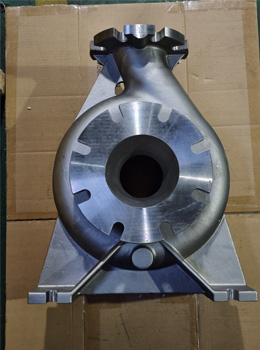
- English
- Español
- Português
- русский
- Français
- 日本語
- Deutsch
- tiếng Việt
- Italiano
- Nederlands
- ภาษาไทย
- Polski
- 한국어
- Svenska
- magyar
- Malay
- বাংলা ভাষার
- Dansk
- Suomi
- हिन्दी
- Pilipino
- Türkçe
- Gaeilge
- العربية
- Indonesia
- Norsk
- تمل
- český
- ελληνικά
- український
- Javanese
- فارسی
- தமிழ்
- తెలుగు
- नेपाली
- Burmese
- български
- ລາວ
- Latine
- Қазақша
- Euskal
- Azərbaycan
- Slovenský jazyk
- Македонски
- Lietuvos
- Eesti Keel
- Română
- Slovenski
- मराठी
- Srpski језик
HY introduces you to the casting process
2024-01-03
Die casting
It is a metal casting process characterized by applying high pressure to molten metal using a mold cavity, usually machined from a stronger alloy.
Sand mold casting
Sand mold casting requires placing a finished part model or wooden model (pattern) in the sand, and then filling the sand around the pattern. After the pattern is taken out of the box, the sand will form a casting mold. In order to take out the model before pouring the metal, the casting mold should be made into two or more parts; during the mold making process, holes and vents for pouring metal into the mold must be left to form a pouring system. After the metal liquid is poured into the mold, it is kept for an appropriate period of time until the metal solidifies. After the parts were removed, the molds were destroyed, so new molds had to be made for each casting.
Investment casting
Also known as lost wax casting, it includes processes such as pressing wax, trimming wax, forming trees, dipping slurry, melting wax, pouring molten metal and post-processing. Lost wax casting uses wax to make a wax pattern of the part to be cast, and then coats the wax pattern with mud, which is the clay mold. After the clay mold is dried, it is fired into a pottery mold. Once fired, all the wax mold melts and disappears, leaving only the pottery mold. Generally, the pouring port is left when making the mud mold, and then the molten metal is poured into the pouring port. After cooling, the required parts are made.
Die forging
It is a forging method that uses a die to form a blank on a special die forging equipment to obtain a forging. According to different equipment, die forging is divided into hammer die forging, crank press die forging, flat forging machine die forging, friction press die forging, etc. Under the action of a pair of counter-rotating dies, plastic deformation occurs to obtain the required forgings. It is a special form of forming rolling (longitudinal rolling).
Forging
It is a processing method that uses forging machinery to exert pressure on metal blanks to cause plastic deformation to obtain forgings with certain mechanical properties, shapes and sizes. It is one of the two major components of forging (forging and stamping). Forging can eliminate defects such as loose as-cast metal produced during the smelting process and optimize the microstructure. At the same time, due to the preservation of complete metal streamlines, the mechanical properties of forgings are generally better than castings of the same material. Important parts in related machinery with high loads and severe working conditions mostly use forgings, except for simple shapes that can be rolled plates, profiles or welded parts.


Rolling
Also known as calendering, it refers to the process of passing a metal ingot through a pair of rollers to give it a shape. If the temperature of the metal exceeds its recrystallization temperature during rolling, the process is called "hot rolling", otherwise it is called "cold rolling". Calendering is the most commonly used method in metal processing.
Pressure casting
Under the action of high pressure, liquid or semi-liquid metal fills the die-casting mold (die-casting mold) cavity at a high speed, and forms and solidifies under pressure to obtain a casting.
Low pressure casting
A casting method in which liquid metal fills a mold and solidifies into a casting under the action of low-pressure gas. Low-pressure casting was initially mainly used for the production of aluminum alloy castings, and later its use was further expanded to produce copper castings, iron castings and steel castings with high melting points.
Centrifugal casting
The technology and method of injecting liquid metal into a high-speed rotating casting mold so that the molten metal fills the mold and forms a casting under the action of centrifugal force. The casting mold used in centrifugal casting, depending on the shape, size and production batch of the casting, can be a non-metallic mold (such as a sand mold, a shell mold or an investment shell mold), a metal mold, or a coating layer or a resin sand layer inside the metal mold. of casting.
Lost foam casting
Paraffin wax or foam models similar in size and shape to the castings are bonded and combined into model clusters. After being painted with refractory paint and dried, they are buried in dry quartz sand and vibrated to form shapes. They are cast under negative pressure to vaporize the models and occupy them with liquid metal. Model position, a new casting method that forms a casting after solidification and cooling. Lost foam casting is a new process with nearly no margin and accurate molding. This process does not require mold taking, no parting surface, and no sand core. Therefore, the casting has no flash, burrs, and draft slope, and reduces the number of mold core defects. Dimensional errors caused by combination.
Squeeze casting
Also known as liquid die forging, molten metal or semi-solid alloy is directly injected into an open mold, and then the mold is closed to generate a filling flow to reach the external shape of the workpiece, and then high pressure is applied to make the solidified metal (shell ) produces plastic deformation, the unsolidified metal is subjected to isostatic pressure, and high-pressure solidification occurs at the same time, and finally the method of obtaining a part or blank is the method of direct squeeze casting; there is also indirect squeeze casting, which refers to passing molten metal or semi-solid alloy through A method in which the punch is injected into a closed mold cavity and high pressure is applied to cause it to crystallize and solidify under pressure, and finally a part or blank is obtained.
Continuous casting
A casting method in which liquid metal is continuously poured into one end of a penetrating crystallizer and the molding material is continuously drawn out from the other end.
Pulling
A plastic processing method that uses external force to act on the front end of the metal being pulled to pull the metal blank from the die hole smaller than the cross section of the blank to obtain products of the corresponding shape and size. Since drawing is mostly carried out in a cold state, it is also called cold drawing or cold drawing.



